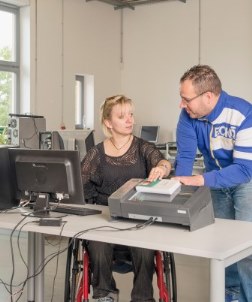KANBrief 2/16

Within society and public policy, a paradigm shift has taken place with regard to equal rights to participation by persons with disabilities: away from well-meaning paternalism and towards the right to self-determination. One criterion for self-determined participation is an environment that is designed for accessibility. The DGUV's "Design of accessible workplaces" subcommittee aims to contribute to this process by providing companies, institutions and individuals with information and practical aids.
"One world of education and work for all": with this concept, the "Design of accessible workplaces" subcommittee has taken account of inclusion and thus of the core sentiment of the UN Convention on the Rights of Persons with Disabilities. The subcommittee's aim is to contribute to accessible design in the world of education and work, not least through implementation of a range of measures from the DGUV Action Plan (see KANBrief 2/16). This concerns not only building measures, but work equipment, communications systems, software, and escape and rescue concepts.
Practical aids
At present, the focus lies upon the development of a range of practical aids that are intended to assist companies in assessing their own situation regarding accessibility and that propose suitable solutions. A key module is the Guide to design for accessible work (in german):
The brochure on the Accessible design of workplaces (pdf, in german), with its checklist for application in the field in companies, enables small and medium-sized enterprises in particular to assess accessibility within their own operations very easily. The questions and information contained in the brochure are reduced to the essential core requirements. The questions, and the specified dimensions, which serve only as examples, are intended to motivate users to consider the relevant needs within their own companies.
The subcommittee's restructured Internet portal will be available by mid-2016. It will serve as a single point of access for the public to the wide range of information, activities and tools available from the DGUV and the individual accident insurance institutions. In addition, individual accident insurance institutions (such as the VBG (German Social Accident Insurance Institution for the administrative sector)) and the Institute for Work and Health (IAG) provide seminars on accessible design for planners, severely disabled persons' representatives and other target groups.
Establishing accessibility within standards
Active participation in standardization activity is an elementary component of the subcommittee's work, since this is the only way to influence accessible design, for example of work equipment or software, at the earliest opportunity.
On the international level, involvement in standardization work has been focussed upon generic documents such as ISO/IEC Guide 71:2014, Guide for addressing accessibility in standards, which has been adopted in Europe in the form of CEN-CENELEC Guide 6:2014. The guide is intended for standards bodies, and describes how the interests of older and disabled persons should be considered in standards governing products, buildings and services.
The ISO/TR 22411:2008 (Ergonomics data and guidelines for the application of ISO/IEC Guide 71 (currently under Revision)) Technical Report has the function of assuring better comprehensibility of the general provisions formulated in ISO/IEC Guide 71. The Technical Report contains concrete ergonomic data and findings on human abilities in the interests of accessible design.
An important current project at national level in Germany is DIN Technical Report 124, Products in Design for All. The members of the subcommittee are actively involved in updating the existing data concerning human requirements. In addition, aspects omitted from ISO/IEC Guide 71 and ISO/TR 22411 but nevertheless considered important at national level are to be safeguarded in order for this and further content to be presented to the international standardization process at a future time.
Hans-Jürgen Penz Daniel Gruyters
hans-juergen.penz@vbg.de daniel.gruyters@vbg.de